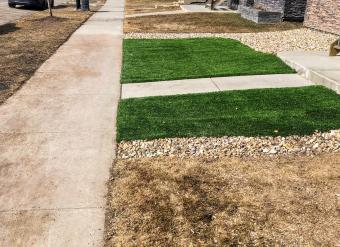
A lush, green lawn next year starts with the work you put in this fall. With the proper fall lawn care and preparation now, your lawn will be even healthier next spring.
Simple Fall Lawn Care Tips
The whole point of fall lawn care is to get next year's lawn off to a healthy start, so you'll have a prettier, healthier lawn and fewer issues right from the beginning.

Aerate Your Lawn
If your lawn area is compacted and the grass is having a hard time growing, this is a good time to consider aerating it. This loosens the soil by removing plugs and incorporating air into the soil, which makes for stronger root growth for your lawn.
Consider Pest Control
You'll also want to try to get ahead of any possible pest problems for next year. If you had issues with insect pests or diseases, this is the time to properly identify them and treat your lawn for it so you're not struggling with the same problems next year.
Remember to Apply Weed Control
If you've had problems with weeds in your lawn this year, fall is a good time to apply a pre-emergent herbicide, which will prevent any weed seeds in your lawn from germinating next spring. Be sure to carefully follow the instructions on whichever product you choose to use.
However, lawn care expert Adam Jones, Vice-President of Quality Assurance for Massey Services, notes, "The best method to control weeds is a dense, healthy lawn. Proper fertilization, mowing, and watering are the foundation for a healthy lawn."
Understand Fall Lawn Fertilizing
Fertilizing your lawn in the fall allows it to build up a reserve of nutrients, which will help it grow stronger and green up more in the spring. Look for a fertilizer specifically formulated for lawns.
It's important to understand the chemical content of your fertilizer too, Jones explains. "The three numbers on a fertilizer bag indicate the amount of primary nutrients by weight," he says. "The three primary nutrients are nitrogen, phosphorus, and potassium (N-P-K). For example, a 50-pound bag of 16-0-8 lawn fertilizer contains eight pounds of nitrogen, zero pounds of phosphorus, and four pounds of potassium."

Look for a fertilizer analysis (N-P-K) that has a 1-0-1 or 2-0-1 nutrient ratio. For example, a 16-0-16 or 20-0-20 is a 1-0-1 ratio fertilizer and 16-0-8 or 20-0-10 is a 2-0-1 ratio fertilizer. A lawn fertilizer should not include phosphorus (the middle number) unless a soil test has indicated the need to supply additional phosphorus. If any of this seems confusing, a simple lawn fertilizer chart can help.
Be sure to follow the instructions on whichever fertilizer you choose and apply it at the recommended rate and timing. The timing is important to get right, since if you fertilize too early, you'll have lots of lush green growth in the fall and the nutrients will be mostly used up by next spring. If you fertilize too late the lawn won't have enough time to build up the nutrient reserves it needs for lush growth in the spring.
Fill Bare Spots and Overseed
If you have bare or thin spots in the lawn, fall is an excellent time to seed those areas so they'll be filled in next spring. It's also the perfect time to overseed the entire lawn, which will result in a thicker turf. This, in turn, will reduce the number of weeds you'll have to deal with next year.
You'll want to sow grass seed no later than 45 days before your first fall frost to give the new grass plenty of time to get established.
Continue to Water the Lawn in Fall
Fall lawn maintenance continues until it gets too cold for the grass to continue growing. This happens at different times dependent on location, and obviously happens sooner in the north than it does in the south.
If you're not getting any rain, you should continue watering your lawn until growth halts for the year. In the north, this is usually sometime in October, but it's later in the south. Lawns need about an inch of water per week.
Give the Lawn a Final Mowing
You should continue mowing the lawn until it stops growing, and you'll want to make sure to give it a good, final mowing before everything freezes. Tall grass can become matted down over the winter and end up with mold and fungal issues as a result.
Don't Forget About Leaf Removal
When the leaves start falling, you'll want to make sure to remove them from the lawn; they can easily mat down and smother your grass.
The easiest way to do this is to use a mulching lawn mower when you mow the lawn; this both removes the leaves and returns them to your lawn to be broken down as a nutrient source -- all while you're also cutting the grass.
Of course, if you don't have a mulching mower, a good, old-fashioned rake works, too. Add them to your compost pile, alternating with layers of grass clippings or kitchen scraps.

Making a Fall Lawn Care Schedule Helps
When you're handling your fall lawn maintenance, the best advice is to pay close attention to when these various steps should be completed. If some are done too soon, you won't see the benefits you may have expected, and the same is true if they're done too late. It looks like a lot, but with a bit of planning, fall lawn care doesn't have to be a lot of hassle.







